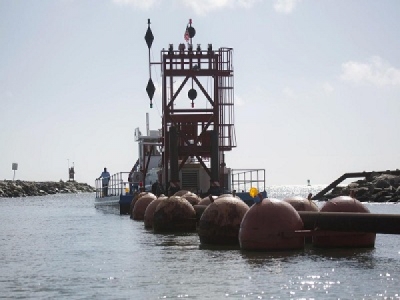
Posted on August 8, 2018
From the shores of Rudee Inlet , the water looked calm. But aboard a johnboat headed for the tip of the rock jetties, the 4-foot swell told a different story.
“Out here, where the waves start to crest, that’s where the shoaling begins,” Lonnie Gregory, assistant superintendent for the city’s dredging operation, said Thursday morning.
The growing sand pile near the entrance of the Oceanfront’s marina district has become a safety issue.
Last weekend, a 92-foot luxury yacht struck bottom just outside of the inlet on the final day of a marlin fishing tournament.
Virginia Beach promptly issued a notice for emergency dredging. But the city’s dredge can’t contend with the southeast wind that whips up the waves.
“The conditions have to be almost perfect to work outside of the channel,” said Jason Wilson, public works engineer.
The dredge, called the Rudee Inlet II, typically is used to empty the sand trap in an area protected by the southern jetty. But the 103-foot-long metal boat can work in swells no more than 2½ feet .
A digging spud at the stern keeps the vessel in place while a cutter head at the bow creates a slurry of sand and water that is pumped into pipes and deposited north on the resort beach.
Wave action could snap the spud.
“It’ll sink it,” Gregory said.
“Or hurt somebody,” said Al Bevan, a dredge mechanic. “That’s something you got to think about.”
For now, it sits idle until the wind diminishes.
“We’re not expecting the conditions to improve,” Wilson said Thursday morning on the beach at Croatan. “It’s bad timing. This is a busier time for the inlet.”
But help is on the way.
The Currituck, a hopper dredge built for open sea, will arrive in Virginia Beach earlier than expected.
“We’ve moved up the dredge schedule,” Patrick Bloodgood, spokesman for the Norfolk District of the Army Corps of Engineers, told The Pilot Thursday afternoon.
It will arrive to knock down the shoals in Rudee Inlet on Aug. 10.
The dredge is in Ocean City, Md., and had been expected to arrive in Virginia Beach near the end of the month.
“If they’re able to get here sooner, that’s the best thing for us,” Wilson said.
Photo of some of luxury boats docked inside Rudee Inlet in Virginia Beach, Virginia. Recently a sandbar has formed just outside the jetty rocks, the city’s dredge needs 2 1/2 feet or less of wave conditions to operate correctly and safely outside of the inlet and it is on stand by waiting for those conditions.
The inlet is a tourist hot spot with Jet Skis, parasail boats, dolphin-watching expeditions and pirate cruises running through several times a day during the summer.
Paddleboard instructor Randy Harris has been guiding beginners through unusually rough swells.
“We have to be careful going out,” he said. “The waves break in the middle of the channel.”
Rudee Inlet II, the city of Virginia Beach’s dredge, Aug. 2, 2018, is used to keep the inlet at a passable depth for commercial and personal boats. Recently a sandbar has form just outside the jetty rocks, the city’s dredge needs 2 1/2 feet or less of wave conditions to operate correctly and safely outside of the inlet and it is on stand by waiting for those conditions.
Rudee Inlet is manmade, and the city, along with the corps, have been dredging it for years, as currents push sand from the south to the north. Some of it ends up in the sand trap, but some collects around the tip of the rocks.
“It’s always been a constant battle,” Gregory said.
The Lost Pearl a commercial tourist boat makes its way out of the Rudee Inlet, Aug. 2, 2018. Recently a sandbar has form just outside the jetty rocks, the city’s dredge needs 2 1/2 feet or less of wave conditions to operate correctly and safely outside of the inlet and it is on stand by waiting for those conditions.
The city and the corps aim to maintain a depth of 14 feet below mean low water at the entrance channel. A recent survey revealed a depth of 4 feet on the south side at the tip of the jetties and 6 to 7 feet on the north side.
Mariners have been notified of the treacherous conditions.
“They need to be smart captains when they come through,” Wilson said. “Go through during high tide.”
Source: The Virginian-Pilot





